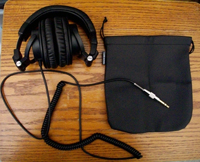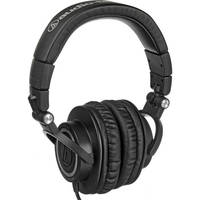Review of the Audio-Technica ATH-M50 Headphones
I have been using a new pair of headphones – the Audio-Technica ATH-M50 – and saying bad words, because they are revealing details (not the good kind) of my recordings about which I have been blissfully unaware. This is a GOOD thing.
The ideal for any kind of monitoring in your home recording studio is accuracy. The more flaws you can detect in your audio, the more you can tweak and fix that audio. As a result, your finished product will be that much better.
The Audio-Technica ATH-M50 is designed for professional monitoring and mixing. This means that they aren’t designed to make your audio sound good by boosting certain frequencies, as you’d expect from consumer headphones for your iPod, for example. They are designed to tell you the truth, warts and all, about your audio; and as I mentioned above, this they do extremely well.
But despite the fact that they are designed for reference monitoring, they still do sound fantastic listening to well-recorded music. They are even quite popular among the audiophile crowd.
The Basics
These “cans” (as they call them in the biz) are of the closed-back design, making them perfect not only for critical listening, but also for artists to wear when recording. The closed back keeps the music or click-track from leaking into the mic. They will also provide isolation from extraneous sounds (cars, cats, lawnmowers, etc) while you concentrate on the audio.
They are also circumaural, which means the padding goes around your ears instead of smashing them against your head. This lets you wear them comfortably for long periods of time. Additionally, this model has the spiral coiled cable rather than the straight cable. I prefer the coiled variety because I’m less afraid of clotheslining myself. But if you prefer the straight cable, the ATH-M50 offers those as well. Be sure you know which one you order though, when buying, so you don’t get the wrong kind. Both varieties are single-sided, meaning that the cable only comes out of one ear cup rather than both. This makes them less apt to tangle around things.
Other Specs
- Large 45mm neodymium drivers
- 15Hz – 28Khz frequency response
- 3.5mm mini plug with 1/4-inch threaded adapter
- Swiveling ear cups that can rotate out 180 degrees – useful if you only want to listen with one ear
- Collapsible for convenient stuffing into the carrying bag that comes with them

The listed dynamic range for these phones is HUGE, especially considering that the range of human hearing is considered to only be 20Hz to 20KHz. This is one reason why they sound so freaking awesome though.
The Real World
Enough with the numbers – how did they perform in the real world? Well there is no question that these are serious headphones, designed for professional use. The sound, as I may have already mentioned, is awesome. That’s going to be the main factor with headphones. Since I, like anyone whose home studio is in a converted rectangular bedroom, have an imperfect listening space, having high quality headphones that can give me accurate sonic information is crucial. And the $159 cost for these headphones is certainly less expensive than paying someone to come out and install acoustic treatment in my studio, followed by purchasing top-of-the-line loudspeakers, many thousands of dollars in all.
My only quibble is that these headphones weren’t as comfortable as my old ones, the Sennheiser HD-280 Pro, which are also closed-back, circumnaural cans (and about a third the price!). They seemed a bit tight on my big noggin. A bit of looking around on the web about this, though, showed that this is common for some people when the phones are new. But everyone says that they stretch and loosen after wearing them for awhile, like a new pair of shoes. So I don’t expect this to be a problem for me.
In summary – if you are looking for a pair of really good, professional headphones that will take your recordings to the next level, and you want to do that for under $200, then these headphones are perfect.

